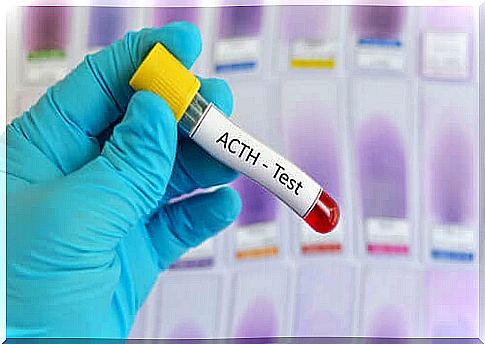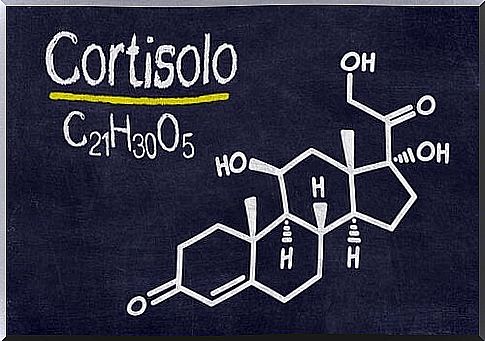Adrenocorticotropic Hormone: Characteristics And Functions

Adrenocorticotropic hormone or corticotropin (ACTH) is a hormone produced by the pituitary gland, the main endocrine gland of vertebrates, also known as the pituitary gland. The hormones it produces control the functioning of almost all of the other endocrine glands in the body (1).
Thus, the adrenocorticotropic hormone is a corticotropic cell. The latter mainly produce corticotropic hormones which are placed in the center. In the following space we will analyze the characteristics of this hormone in particular.
Synthesis of adrenocorticotropic hormone
This hormone is synthesized from a protein called proopiomelanocortica (POMC). This precursor protein is made up of 266 amino acids, and the adrenocorticotropic hormone is made up of 39 amino acids. Furthermore, prropiomelanocortica also generates other peptides, such as:
- Lipotropin.
- Endorphin.
- Met-enkephalin.
- Melanocyte stimulating hormone.
- Corticotropin-like intermediate peptide (CLIP).

Secretion of adrenocorticotrophin
The secretion of the adrenocorticotropic hormone is pulsating. This means that it follows a characteristic circadian rhythm. Thus, it reaches its peak six hours after production in the body and its lowest levels at midnight.
Thanks to the secretion of adrenocorticotrophin, adrenal glucocorticoids are secreted, according to a parallel diurnal pattern. Finally, the biological average life of ACTH in the circulation is less than ten minutes.
Modulators of ACTH synthesis and / or secretion
Activators
- CRH (main modulator).
- TNF (tumor necrosis factor).
- IL-1 (interleukin 1).
- CKK (cholecystokinin).
- VIP (vasoactive intestinal peptide).
- Alpha-adrenergic receptors.
- Acetylcholine.
- Serotonin.
Inhibitors
- Cortisol (main modulator).
- GABA.
- Endorphins.
- Enkephalins.
- Activin.
- Galanine.
- PNA (nucleic peptide acid).
- Substance P.
Mechanism of action of adrenocorticotropic hormone
Adrenocorticotropic hormone acts via a transmembrane receptor. This receptor is known as melanocortin receptor 2, a G-protein-coupled receptor. In cAMP it acts as a second biological messenger.
Action
Adrenocorticotropic hormone works as follows:
- Preserves homeostasis of metabolism and modulates the endocrine reaction to stress.
- It induces esteroidogenesis, a set of metabolic reactions that mainly make it possible to synthesize steroid hormones within a specific organ or tissue (corticoids, androgens, and, to a lesser extent, mineralocorticoids).
- It stimulates skin pigmentation, which is determined by the amount of melanin in the skin. This is due to the fact that it contains the sequence of melanocyte stimulating hormones (MSH) in its molecule.
- In addition, it produces a certain level of lipolysis: the breakdown of dietary lipids into fatty acids during digestion.
The clinical picture with inhibition of ACTH and the adrenal axis often occurs due to the administration of corticoids. For example in asthma, collagenopathies and haematological diseases (1).
Diseases associated with ACTH
Cushing’s syndrome
This syndrome collects a series of clinical and biochemical abnormalities that are the result of chronic exposure to excess cortisol produced by the adrenal cortex. Between 80 and 85% of this syndrome is due to an adrenocorticotropic hormone-producing pituitary adenoma (3).
The differential diagnosis of Cushing’s syndrome represents one of the greatest challenges of endocrinology. Although the clinical manifestations are obvious in several cases, in others they can be very subtle. Weight gain with central redistribution of fat accumulating on the face, neck, torso and abdomen is one of those most common clinical findings (4).
Well, other important clinical data are the presence of facial plethora, hirsutism, acne and menstrual disorders, hypertension and proximal muscle weakness, stretch marks, carbohydrate intolerance or diabetes (5).

Addison’s disease and ACTH (6)
Addison’s disease is a syndrome characterized by the absence of glucocorticoids and / or mineralocorticoids. In these cases, poor ACTH production may occur, leading to decreased glucocorticoid production (secondary hypoadrenocorticism).
Secondary hypoadrenocorticism (HAS) can be natural or iatrogenic. The natural form is due to the absence of normal adrenal stimulus via CRH or ACTH and denotes primary pituitary or hypothalamic insufficiency. Thus, most of these cases are the result of inflammation, tumors, trauma or congenital hypothalamic or pituitary deficiencies.
The iatrogenic form is the most common form of HAS in the veterinary setting and occurs due to the exogenous administration of glucocorticoids, which suppress normal pituitary ACTH production. This nourishes the bilateral adrenal atropine.
Addison’s disease is a slow and gradual process, caused by the low production of adrenal hormones compared to the normal needs of the body. It originates from the bilateral destruction of the adrenal cortex. Furthermore, there is no symptomatology, apparently, up to the loss of 90% or more of adrenal tissue (7).
Concluding reflections on adrenocorticotropic hormone
Therefore, the adrenocorticotropic hormone is a fundamental hormone for the correct functioning of the nervous system. In fact, its malfunction favors the development of some diseases such as the ones we have seen, as well as other hormonal disorders.
To conclude, there is still a lot to discover about this hormone, but the importance of its role in the body seems to be clear.









